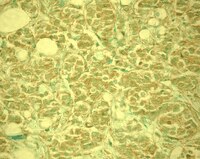OP143 Sigma-AldrichAnti-MDM2 (Ab-3) Mouse mAb (4B11)
This Anti-MDM2 (Ab-3) Mouse mAb (4B11) is validated for use in Immunoblotting, Immunofluorescence, Immunoprecipitation, Paraffin Sections for the detection of MDM2 (Ab-3).
More>> This Anti-MDM2 (Ab-3) Mouse mAb (4B11) is validated for use in Immunoblotting, Immunofluorescence, Immunoprecipitation, Paraffin Sections for the detection of MDM2 (Ab-3). Less<<Synonyms: Anti-Ubiquitin Protein Ligase, Anti-p53 Binding Protein, Anti-Murine Double Minute Chromosome-2
Recommended Products
개요
| Replacement Information |
|---|
주요 사양표
| Species Reactivity | Host | Antibody Type |
|---|---|---|
| H, M | M | Monoclonal Antibody |
가격 및 재고여부
| 카탈로그 번호 | 재고 정보 | 패킹 | 포장 단위 | 가격(VAT 별도) | 수량 | |
|---|---|---|---|---|---|---|
| OP143-100UGCN |
|
Plastic ampoule | 100 μg |
|
— |
| Product Information | |
|---|---|
| Form | Liquid |
| Formulation | In 50 mM sodium phosphate buffer, 50% glycerol. |
| Positive control | A549 cells |
| Preservative | None |
| Quality Level | MQ100 |
| Physicochemical Information |
|---|
| Dimensions |
|---|
| Materials Information |
|---|
| Toxicological Information |
|---|
| Safety Information according to GHS |
|---|
| Safety Information |
|---|
| Product Usage Statements |
|---|
| Packaging Information |
|---|
| Transport Information |
|---|
| Supplemental Information |
|---|
| Specifications |
|---|
| Global Trade Item Number | |
|---|---|
| 카탈로그 번호 | GTIN |
| OP143-100UGCN | 04055977224887 |
Documentation
Anti-MDM2 (Ab-3) Mouse mAb (4B11) MSDS
| 타이틀 |
|---|
Anti-MDM2 (Ab-3) Mouse mAb (4B11) Certificates of Analysis
| Title | Lot Number |
|---|---|
| OP143 |
References
| 참고문헌 보기 |
|---|
| Marchetti, A., et al. 1995. J. Pathol. 175, 31. Barak, Y., et al. 1993. EMBO. J. 12, 461. Ladanyi, M., et al. 1993. Cancer Res. 53, 16. Leach, F. S., et al. 1993. Cancer Res. 53, 2231. Oliner, J. D., et al. 1993. Nature 362, 857. Momand, J., et al. 1992. Cell 69, 1237. Oliner, J. D., et al. 1992. Nature 358, 80. Fakharzadeh, S. S., et al. 1991. EMBO. J. 10, 1565. |
Citations
| 타이틀 | |
|---|---|
|
|
| Data Sheet | ||||||||||||||||||||||||||||||||||||||||||||||||||
|---|---|---|---|---|---|---|---|---|---|---|---|---|---|---|---|---|---|---|---|---|---|---|---|---|---|---|---|---|---|---|---|---|---|---|---|---|---|---|---|---|---|---|---|---|---|---|---|---|---|---|
|
Note that this data sheet is not lot-specific and is representative of the current specifications for this product. Please consult the vial label and the certificate of analysis for information on specific lots. Also note that shipping conditions may differ from storage conditions.
|








